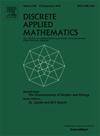Some new results on bar visibility of digraphs
IF 1
3区 数学
Q3 MATHEMATICS, APPLIED
引用次数: 0
Abstract
Visibility representation of digraphs was introduced by Axenovich et al. (2013) as a natural generalization of -bar visibility representation of undirected graphs. A -bar visibility representation of a digraph assigns each vertex at most horizontal bars in the plane so that there is an arc in the digraph if and only if some bar for “sees” some bar for above it along an unblocked vertical strip with positive width. The visibility number is the least such that has a -bar visibility representation. In this paper, we solve several problems about posed by Axenovich et al. and prove that determining whether the bar visibility number of a digraph is 2 is NP-complete.
关于条形图可见性的一些新结果
数图的可见性表示是由 Axenovich 等人(2013 年)提出的,是对无向图的 t 条可见性表示的自然概括。数图 G 的 t 条可见度表示法为每个顶点在平面上分配了最多 t 条水平条,因此当且仅当 x 的某个条沿着宽度为正的无阻挡垂直条 "看到 "其上方 y 的某个条时,数图中才有弧 xy。可见度数 b(G) 是 G 具有 t 条可见度表示的最小 t。在本文中,我们解决了阿克森诺维奇等人提出的几个关于 b(G) 的问题,并证明确定一个数图的条形可见度数是否为 2 是 NP-完全的。
本文章由计算机程序翻译,如有差异,请以英文原文为准。
求助全文
约1分钟内获得全文
求助全文
来源期刊

Discrete Applied Mathematics
数学-应用数学
CiteScore
2.30
自引率
9.10%
发文量
422
审稿时长
4.5 months
期刊介绍:
The aim of Discrete Applied Mathematics is to bring together research papers in different areas of algorithmic and applicable discrete mathematics as well as applications of combinatorial mathematics to informatics and various areas of science and technology. Contributions presented to the journal can be research papers, short notes, surveys, and possibly research problems. The "Communications" section will be devoted to the fastest possible publication of recent research results that are checked and recommended for publication by a member of the Editorial Board. The journal will also publish a limited number of book announcements as well as proceedings of conferences. These proceedings will be fully refereed and adhere to the normal standards of the journal.
Potential authors are advised to view the journal and the open calls-for-papers of special issues before submitting their manuscripts. Only high-quality, original work that is within the scope of the journal or the targeted special issue will be considered.
 求助内容:
求助内容: 应助结果提醒方式:
应助结果提醒方式:


